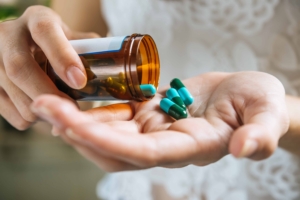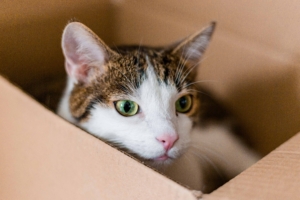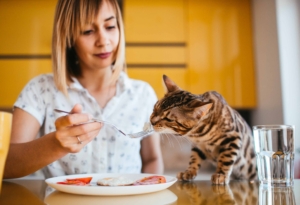Common Household Pet Dangers

From human food to plants, insects, and shoes, our pets are masters at finding anything that smells good. However, what they find may not necessarily be good for them. Here are some of the most common dangers you might find around your home.

Medications
While some human medications are thought to be safe for your pet, you should always consult your veterinarian before giving them anything. Pet poisonings after ingesting human medication are common and can be very serious. Here are some human medications that are known to be dangerous:
- Ibuprofen and aspirin
- Acetaminophen
- Cold and flu meds
- Antidepressants
- Sleep Aids
- Vitamins
- Diet pills
- Birth Control
Dr. Ahna Brutlag at Pet Poison Helpline has some tips to help prevent your pets from getting into medication:
- Never leave loose pills in a plastic Ziploc® bag as plastic bags are easy to chew into.
- If you place your medication in a weekly pill container, make sure to keep the container out of reach of your pets, as some pets may consider the pill container a chew toy.
- Never store your own medications near your pet’s medications. The Pet Poison Helpline frequently receives calls from owners who have accidentally given their own medication to their pet.
- Hanging your purse up can help to avoid exposure to any potentially dangerous medications.

Packaging
Right now, many of us are ordering various things online, but as pet parents, we need to be mindful of any packaging we leave around as it could be harmful to our pets. The three most common packaging dangers are Styrofoam, cardboard, and bags.
Packaging like Styrofoam is toxic if ingested because it is made from plastic, and our pets cannot digest it. Your pet’s liver and kidneys will try to process the Styrofoam leading to the organs becoming more overworked.
While there isn’t anything in standard cardboard that is toxic to your pet, it is not a good idea to let them consume it as it can lead to a gastric or intestinal obstruction. These obstructions have the potential to become life-threatening. Common symptoms associated with an obstruction are:
- Vomiting
- Constipation
- Diarrhea
- A fever in excess of 103 degrees
- Refusing to eat or drink
- Pain in their abdomen
If your pet displays any of these symptoms, give us a call as soon as possible for a checkup to see what is causing the symptoms and to get the appropriate treatment.
As part of our online orders, many clothing and small items come wrapped in plastic bags, and most dogs are attracted to the crinkle sound the bag makes. If your pet happens to get their head stuck in a bag, they will be unable to get the bag off their head and are at an increased risk of suffocation. It is recommended that any plastic bags that you bring into your house that you cut the sides to eliminate the risk of a pet getting their head stuck.

Plants
Plants are so pretty to look at, and they even can smell good too, but what our pets don’t know is which ones are safe for a snack. The plants listed below are toxic to our pets. If you have any of these plants around your home, make sure they are out of reach of your pet.
| – African Violet – Amaryllis – Areca Palm – Autumn Crocus – Azalea – Baby Rubber Plant – Ball Fern – Bird of Paradise – Boston Fern – Bromeliads – Calla Lily – Christmas Cactus – Daffodil – Dieffenbachia – Dracaena – Eucalyptus – Ficus – Gladiolas |
– Honeysuckle – Hyacinth – Hydrangea – Iris – Lilies – Lily of the Valley – Morning Glory – Oleander – Philodendron – Pothos – Rose – Rhododendron – Sago Palm – Spider Plant – Tulip – Variegated Wax Plant – Wisteria – Zinnia |
Please note that this plant list is not meant to be all-inclusive, but of the most frequently encountered plants.
Small Objects
Our pets are good at turning ordinary objects into a play toy. As pet owners, we need to be watchful as some objects are small enough for them to swallow, injuring their mouth or organs, or needing surgery to remove the object. Keep small objects like the ones listed below out of your pet’s environment, that way they’re less likely to swallow them.
- Buttons
- Q-tips
- Bobby pins
- Pen caps
- Paper Clips
- Bottle Tops
- Lego Blocks
- Board Game Pieces

Food
Some foods that are good for us can be very dangerous for our pets to eat. Below are some of the common dangers for our pets to eat:
- Alcoholic beverages
- Apple seeds
- Apricot pits
- Avocados
- Cherry pits
- Candy (particularly chocolate—which is toxic to dogs, cats, and ferrets—and any candy containing the toxic sweetener Xylitol)
- Coffee (grounds, beans, and chocolate-covered espresso beans)
- Garlic
- Grapes
- Gum (can cause blockages and sugar free gums may contain the toxic sweetener Xylitol)
- Hops (used in home beer brewing)
- Macadamia nuts
- Moldy foods
- Mushroom plants
- Mustard seeds
- Onions and onion powder
- Peach pits
- Potato leaves and stems (green parts)
- Raisins
- Rhubarb leaves
- Salt
- Tea (because it contains caffeine)
- Tomato leaves and stems (green parts)
- Walnuts
- Xylitol (artificial sweetener that is toxic to pets)
- Yeast dough
Please note that this food list is not meant to be all-inclusive, but of the most frequently encountered food dangers.
Remember, if you suspect your pet has had contact with or ingested anything poisonous, call your veterinarian or the Pet Poison Helpline as soon as possible. Time could be a lifesaver!
